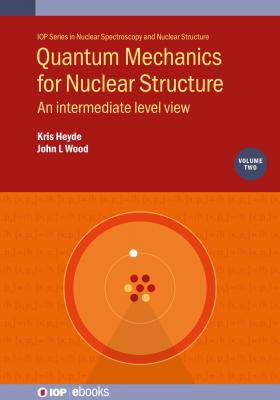Quantum Mechanics for Nuclear Structure, Volume 2. Professor Kris Heyde
Чтение книги онлайн.
Читать онлайн книгу Quantum Mechanics for Nuclear Structure, Volume 2 - Professor Kris Heyde страница 8

The states ∣n+〉, ∣n−〉 can be written in the combined form ∣n+n−〉 which, from
[a−,a+†]=[a−,a+]=[a−†,a+†]=[a−†,a+]=0,(1.121)
obey
∣n+n−〉=a+†n+a−†n−n+!n−!∣00〉,(1.122)
Nˆ+∣n+n−〉=n+∣n+n−〉,Nˆ−∣n+n−〉=n−∣n+n−〉,(1.123)
a+†∣n+n−〉=n++1∣n++1,n−〉,a−†∣n+n−〉=n−+1∣n+,n−+1〉,(1.124)
a+∣n+n−〉=n+∣n+−1,n−〉,a−∣n+n−〉=n−∣n+,n−−1〉,(1.125)
a+∣00〉=0,a−∣00〉=0.(1.126)
Then, from equations (1.111) and (1.115), i.e.
Jˆ+=a+†a−,Jˆ−=a−†a+,Jˆ0=12a+†a+−a−†a−=12(Nˆ+−Nˆ−),(1.127)
together with
Nˆ≔Nˆ++Nˆ−=a+†a++a−†a−(1.128)
and
Jˆ2≔Jˆ02+12(Jˆ+Jˆ−+Jˆ−Jˆ+),(1.129)
we obtain:
Jˆ+∣n+n−〉=n−(n++1)∣n++1,n−−1〉,(1.130)
Jˆ−∣n+n−〉=n+(n−+1)∣n+−1,n−+1〉,(1.131)
Jˆ0∣n+n−〉=12(n+−n−)∣n+n−〉,(1.132)
Nˆ∣n+n−〉=(n++n−)∣n+n−〉,(1.133)
and
Jˆ2∣n+n−〉=Jˆ02∣n+n−〉+12Jˆ+Jˆ−∣n+n−〉+12Jˆ−Jˆ+∣n+n−〉=14(n+−n−)2∣n+n−〉+12n+(n−+1)∣n+n−〉+12n−(n++1)∣n+n−〉=n++n−2n++n−2+1∣n+n−〉=n2n2+1∣n+n−〉,(1.134)
where
n=n++n−.(1.135)
Evidently, by making the associations
n+↔j+m,n−↔j−m,(1.136)
we obtain
n=2j;(1.137)
and from equations (1.130)–(1.132) and (1.134)
Jˆ+∣n+n−〉=(j−m)(j+m+1)∣n++1,n−−1〉,(1.138)
Jˆ−∣n+n−〉=(j+m)(j−m+1)∣n+−1,n−+1〉,(1.139)
Jˆ0∣n+n−〉=m∣n+n−〉,(1.140)
Jˆ2∣n+n−〉=j(j+1)∣n+n−〉,(1.141)
respectively. Thus, by comparison with
Jˆ+∣jm〉=(j−m)(j+m+1)∣jm+1〉,(1.142)
Jˆ−∣jm〉=(j+m)(j−m+1)∣jm−1〉,(1.143)
Jˆ0∣jm〉=m∣jm〉,(1.144)
Jˆ2∣jm〉=j(j+1)∣jm〉,(1.145)
we can assert that
∣n+n−〉≡∣jm〉,(1.146)
and from equation (1.122)
∣jm〉≡a+†j+ma−†j−m(j+m)!(j−m)!∣00〉.(1.147)
Two special cases of note are: m=+j, i.e.
∣jj〉≡a+†2j(2j)!∣00〉;(1.148)
and m=−j, i.e.
∣j,−j〉≡a−†2j(2j)!∣00〉.(1.149)
Consider then the rotation of the states ∣j=12,m=12〉≡∣12,12〉 and ∣j=12,m=−12〉≡∣12,−12〉:
Dy(β)12,12↔cosβ2−sinβ2sinβ2cosβ210=cosβ2sinβ2,(1.150)
Dy(β)12,−12↔cosβ2−sinβ2sinβ2cosβ201=−sinβ2cosβ2;(1.151)
i.e.
Dy(β)12,−12=cosβ212,12+sinβ212,−12,(1.152)
Dy(β)12,−12=−sinβ212,12+cosβ212,−12.(1.153)
Then from
12,12=a+†∣0〉,12,−12=a−†∣0〉,(1.154)
we have
Dy(β)12,12=Dy(β)a+†Dy−1(β)Dy(β)∣0〉,(1.155)
Dy(β)12,−12=Dy(β)a−†Dy−1(β)Dy(β)∣0〉;(1.156)
whence
Dy(β)a+†Dy−1(β)≡a+†′=cosβ2a+†+sinβ2a−†,(1.157)
Dy(β)a−†Dy−1(β)≡a−†′=−sinβ2a+†+cosβ2a−†.(1.158)
Thus,
Dy(β)∣jm〉≔a+†′j+ma−†′j−m(j+m)!(j−m)!∣00〉.(1.159)
∴Dy(β)∣jm〉=cosβ2a+†+sinβ2a−†j+m−sinβ2a+†+cosβ2a−†j−m(j+m)!(j−m)!∣00〉.(1.160)
The right-hand side of equation (1.160) can be expanded using the binomial theorem:
Dy(β)∣jm〉=1(j+m)!(j−m)!∑l(j+m)!l!(j+m−l)!a+†cosβ2la−†sinβ2j+m−l×∑k(j−m)!k!(j−m−k)!(−a+†sinβ2)ka−†cosβ2j−m−k∣00〉.(1.161)
∴Dy(β)∣jm〉=(j+m)!(j−m)!∑l,k(−1)kcosβ2j−m+l−ksinβ2j+m−l+kl!(j+m−l)!k!(j−m−k)!×a+†l+ka−†2j−l−k∣00〉,(1.162)
and comparing with
Dy(β)∣jm〉=∑m′∣jm′〉dm′m(j)(β),(1.163)
i.e.
Dy(β)∣jm〉=∑m′dm′m(j)(β)a+†j+m′a−†j−m′(j+m′)!(j−m′)!∣00〉,(1.164)